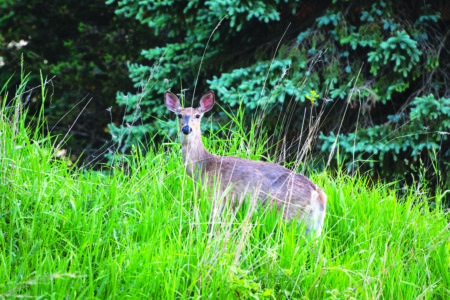Keep on the lookout this summer for spotted lanternfly



By Tara Bal and Sigrid Resh
Is that a weird moth? A ladybug? A fly? No, it’s a spotted lanternfly.
Hopefully, this is not a conversation we will be having in much of the state anytime soon. The spotted lanternfly was confirmed in downstate Michigan last summer in areas of Oakland County near Pontiac. It was first discovered in the United States in Pennsylvania in 2014 and has since spread rapidly to 12 other states. Individual lanternflies have been reported in an even wider area, but infestations have not yet been confirmed.
Spotted lanternfly (Lycorma delicatula) is related to planthoppers, stinkbugs, cicadas, and other ‘true bugs’, with similar mouthparts that they use for piercing and sucking sap out of plants. They can feed on over 70 different plants including grapes, apples, hops and trees like maple, walnut, willows, and birches. The damage it does to grapes and hop vines is especially concerning for many! In its home range in Asia, it prefers to feed on tree-of-heaven (Ailanthus altissama). Tree-of-heaven is another invasive species that has spread readily in southern Michigan and is available to them across much of the state, though only a few are in our area. Regardless, there may be plenty of host plant species around that spotted lanternflies can feed on wherever they might be introduced in Michigan.
Impacts of spotted
lanternfly
While they don’t wipe out all hemlocks or ash trees like some other insect pests, they do have a significant negative impact on the fruit industry, nurseries, landscaping, forestry, and more. Their feeding on the sap of grapes, apples, oaks, etc. creates wounds that weaken and damage the plants. They also excrete a sugary liquid called honeydew, which can cause a sooty black mold to grow on leaves covered in the sticky substance, further weakening plants and attracting hordes of other insects like yellowjackets. Not an ideal situation for vineyards, backyards, home gardens, or forests.
Identification
Adult spotted lanternflies look like 1″ long planthoppers with 4 wings. The upper wings are grayish, patterned with spots and lines, and the hind wings are a spotted bright red that blends into black and white. The nymphs or young have no wings and look like small black and white beetles, developing red spots as they molt and grow from less than ¼ inch to their adult form. The egg masses are cleverly camouflaged, looking like gray lumps of old chewing gum, thin cement, or just a flat gray blob on a tree trunk. Lanternflies lay their eggs on any hard surface outside in the fall, including cars and outdoor furniture, which unfortunately means they are easily moved by humans.
What to do if you see it
There are different types of management options and traps being researched elsewhere, but in Michigan right now being observant and reporting any sightings of spotted lanternflies is the most important thing. If you see what you suspect is a spotted lanternfly, either the adults or nymphs, take pictures, and note the location. Report suspicious egg masses as well. You can easily report it and upload the pictures to the Michigan Invasive Species Information Network (http://www.misin.msu.edu/report/misin/?project=misin) form online or download the app. The DNR Eyes in the Field online reporting system is also easy to use (https://www2.dnr.state.mi.us/ors/Home).
For more information see The Michigan Department of Natural Resources webpage: https://www.michigan.gov/invasives/id-report/insects/spotted-lanternfly
The Keweenaw Invasive Species Management Area (KISMA) is here to help with invasive species concerns: KISMA.up@gmail.com or go to our website https://www.mtu.edu/kisma/.
Research by Dr. Tara Bal (tlbal@mtu.edu), Assistant Professor in forest health, and Dr. Sigrid Resh (scresh@mtu.edu), Coordinator of the Keweenaw Invasive Species Management Area and Research Professor, Michigan Technological University.






